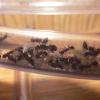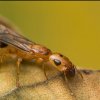- Formiculture.com
- Forums
- Gallery
- Members
- Member Map
- Chat

Formica subsericea diapause questions
Started By
JimmyBruin
, Feb 14 2025 6:46 PM
11 replies to this topic
#1
 Offline
-
Posted February 14 2025 - 6:46 PM
Offline
-
Posted February 14 2025 - 6:46 PM
Hey everyone!
So I have a Formica sub colony going since May in a TH mini hearth. I put them in diapause in my fridge (stays right around 40 pretty consistently) a few months ago. Starting about 4-6 weeks ago, slowly but surely, workers have been coming up to the out word and seem dead or in suspended animation. For the last several weeks it was 6 total but today I noticed there are now 8. There is water in the nestmate and the hydration chamber. I have a byformica feeder filled up top in case they needed it. Back in the fall they seem to want to go into diapause in like late Aug/early September. This is my first ant colony and first time dealing with diapause. Any help y'all could offer would be great, thank you so much!
So I have a Formica sub colony going since May in a TH mini hearth. I put them in diapause in my fridge (stays right around 40 pretty consistently) a few months ago. Starting about 4-6 weeks ago, slowly but surely, workers have been coming up to the out word and seem dead or in suspended animation. For the last several weeks it was 6 total but today I noticed there are now 8. There is water in the nestmate and the hydration chamber. I have a byformica feeder filled up top in case they needed it. Back in the fall they seem to want to go into diapause in like late Aug/early September. This is my first ant colony and first time dealing with diapause. Any help y'all could offer would be great, thank you so much!
#2
 Offline
-
Posted February 14 2025 - 7:06 PM
Offline
-
Posted February 14 2025 - 7:06 PM
Hey everyone!
So I have a Formica sub colony going since May in a TH mini hearth. I put them in diapause in my fridge (stays right around 40 pretty consistently) a few months ago. Starting about 4-6 weeks ago, slowly but surely, workers have been coming up to the out word and seem dead or in suspended animation. For the last several weeks it was 6 total but today I noticed there are now 8. There is water in the nestmate and the hydration chamber. I have a byformica feeder filled up top in case they needed it. Back in the fall they seem to want to go into diapause in like late Aug/early September. This is my first ant colony and first time dealing with diapause. Any help y'all could offer would be great, thank you so much!
A few recommendations: Firstly, this is a bit technical, but try to refer to your colony as Formica subsericea, if that is what they are. Other Formica species start with sub, such as Formica subpolita, and probably more in other regions of the world. If you want to abbreviate the spelling the scientifically accurate way, you can refer to them as F. subsericea after using their full name at least once in your post. Just friendly advice!
As for the issue, I would recommend testing the waters first by removing them from the fridge and observing their behavior. My colonies, which are kept at 47 degrees, will start moving around after being out of the fridge for a minute or two. This is a great way to test whether the workers in the outworld are still alive.
If it does appear that they are dead, there are two things I would do. Firstly, raise the temperature of your fridge. In my experience, Formica, especially F. subsericea, tend to nest deep underground in the warm months, and likely deeper underground in the cold months. This is important because the soil temperature is relatively stable the deeper you go. For example, in Virginia, when 2 feet underground, 40 degrees is about the minimum that the temperatures will ever get1. If the ants are dying it could be because the 40-degree temperature you have them at is at the edge of their tolerance, especially for the underfed nanitics. Otherwise, if this is not the issue, the next thing I would question would be the age of the colony. If this colony is in its second winter, these deaths are likely normal, similar to bee die-offs that happen every winter. If this is the colony's first winter though, then multiple nanitics dying off is unusual. I hope this was helpful!
[1] Build It Solar. (n.d.). Earth temperatures and thermal inertia. Retrieved February 14, 2025, from https://www.buildits...emperatures.htm
- ANTdrew, RushmoreAnts, rptraut and 1 other like this
Go to the ant, you sluggard; consider its ways and be wise! It has no commander, no overseer or ruler, yet it stores its provisions in summer and gathers its food at harvest. -Proverbs 6: 6-8
My Ant Shop Here I have PPQ-526 permits to ship ants nationwide
Attention Ant-Keepers in South Dakota! Join the SoDak(Society Of Dakotan Ant Keepers)
#3
 Offline
-
Posted February 14 2025 - 7:09 PM
Offline
-
Posted February 14 2025 - 7:09 PM
Hey everyone!
So I have a Formica sub colony going since May in a TH mini hearth. I put them in diapause in my fridge (stays right around 40 pretty consistently) a few months ago. Starting about 4-6 weeks ago, slowly but surely, workers have been coming up to the out word and seem dead or in suspended animation. For the last several weeks it was 6 total but today I noticed there are now 8. There is water in the nestmate and the hydration chamber. I have a byformica feeder filled up top in case they needed it. Back in the fall they seem to want to go into diapause in like late Aug/early September. This is my first ant colony and first time dealing with diapause. Any help y'all could offer would be great, thank you so much!o
They are probably treating the outworld like a nest because the fridge turns off the light when you close it and the fridge itself if probably humid, so to them the nest is the same as the outworld for them and that is why they are coming out. They are staying completely still because that is how Formica hibernates/rests.
Keep them in for exactly 3 months or more, and thing less than 3 months will make them very very unhappy and they will completely stop brood production for a long time or even the whole season.
Edit: I also could be wrong with the ants treating the outworld as a nest, but it is a possibility
Edited by OwlThatLikesAnts, February 14 2025 - 7:11 PM.
- JimmyBruin likes this
Currently keeping:
1x Formica subsericea, 20+ workers + a decently sized brood pile, mostly pupa (40-50)
1x Crematogaster cerasi 2 workers with brood (pls don't die workers)
*As you watch your ants march, remember that every thing begins with a small step and continued by diligence and shared dreams*
-A.T (Me)
#4
 Offline
-
Posted February 14 2025 - 7:32 PM
Offline
-
Posted February 14 2025 - 7:32 PM
A few recommendations: Firstly, this is a bit technical, but try to refer to your colony as Formica subsericea, if that is what they are. Other Formica species start with sub, such as Formica subpolita, and probably more in other regions of the world. If you want to abbreviate the spelling the scientifically accurate way, you can refer to them as F. subsericea after using their full name at least once in your post. Just friendly advice!
You also missed Formica subintegra and Formica subnitens, amongst others. That's like saying, "I'm from the U." United States? United Kingdom? Uzbekistan? Clarity is important.
They are probably treating the outworld like a nest because the fridge turns off the light when you close it and the fridge itself if probably humid, so to them the nest is the same as the outworld for them and that is why they are coming out. They are staying completely still because that is how Formica hibernates/rests.
Keep them in for exactly 3 months or more, and thing less than 3 months will make them very very unhappy and they will completely stop brood production for a long time or even the whole season.
This is a possibility if the workers are huddled together. If they are separated from the colony, alone, and not moving, they are likely dead. Also, hibernation timeframes vary drastically depending on region. Here in South Dakota, I would recommend 5 months for hibernation, as that is how long our winters are. In warmer places it could be as low as 2 months.
- ANTdrew, Ants_Dakota and OwlThatLikesAnts like this
"God made..... all the creatures that move along the ground according to their kinds (including ants). And God saw that it was good. Genesis 1:25 NIV version
Keeping:
Formica cf. pallidefulva, cf. incerta, cf. argentea
Formica cf. aserva, cf. subintegra
Myrmica sp.
Lasius neoniger, brevicornis
#5
 Offline
-
Posted February 15 2025 - 4:58 AM
Offline
-
Posted February 15 2025 - 4:58 AM
Ants Dakota - thanks for the heads up regarding being more specific with the names. They are formica subsericea. It is their first diapause and I don't know if I recall many nanitics dying before diapause, so that's probably what it is 😬. I'll take them out for a brief period to see if they're still alive as well as raise the temp 5-10 degrees.
Rushmore ants- I'm in upstate NY which is probably a little warmer than SD, so I'm thinking (hoping) 4 months would be ideal. And that's a good point, the climate dictating diapause length regardless of captivity; something I didn't consider
Owlthatlikesants - I was thinking maybe the same? Hoping lol
Rushmore ants- I'm in upstate NY which is probably a little warmer than SD, so I'm thinking (hoping) 4 months would be ideal. And that's a good point, the climate dictating diapause length regardless of captivity; something I didn't consider
Owlthatlikesants - I was thinking maybe the same? Hoping lol
#6
 Offline
-
Posted February 15 2025 - 7:07 AM
Offline
-
Posted February 15 2025 - 7:07 AM
Title fixed
- OwlThatLikesAnts and MyrmecologyMaven like this
"The ants are a people not strong, yet they prepare their meat in the summer." Prov. 30:25
Keep ordinary ants in extraordinary ways.
Keep ordinary ants in extraordinary ways.
#7
 Offline
-
Posted February 15 2025 - 7:46 AM
Offline
-
Posted February 15 2025 - 7:46 AM
Thanks ANTdrew!
#8
 Offline
-
Posted February 16 2025 - 7:06 AM
Offline
-
Posted February 16 2025 - 7:06 AM
Owlthatlikesants - I was thinking maybe the same? Hoping lol
What I do to check if they are alive is flash a flashlight at them, whenever I do that, they usually start moving very slowly, then they kind of wake up. Also if you are in NY, maybe you should hibernate them for 2-3 months because you guys are actually very close to Montreal, Quebec but New York City is pretty far from Montrea, about 6-8 hours away
Currently keeping:
1x Formica subsericea, 20+ workers + a decently sized brood pile, mostly pupa (40-50)
1x Crematogaster cerasi 2 workers with brood (pls don't die workers)
*As you watch your ants march, remember that every thing begins with a small step and continued by diligence and shared dreams*
-A.T (Me)
#9
 Offline
-
Posted February 16 2025 - 7:56 AM
Offline
-
Posted February 16 2025 - 7:56 AM
Just because northern ants have to endure longer winters doesn’t necessarily mean that they want or need to hibernate that long. Three months will be plenty.
- RushmoreAnts, Ants_Dakota, OwlThatLikesAnts and 1 other like this
"The ants are a people not strong, yet they prepare their meat in the summer." Prov. 30:25
Keep ordinary ants in extraordinary ways.
Keep ordinary ants in extraordinary ways.
#10
 Offline
-
Posted February 17 2025 - 11:08 AM
Offline
-
Posted February 17 2025 - 11:08 AM
Just because northern ants have to endure longer winters doesn’t necessarily mean that they want or need to hibernate that long. Three months will be plenty.
Yeah, I agree just finished hibernating my Formica for 3 months and now they have a nice brood pile of 20+ small larva and eggs I always find that 3 months is the sweet spot for northern species
Edited by OwlThatLikesAnts, February 17 2025 - 11:09 AM.
Currently keeping:
1x Formica subsericea, 20+ workers + a decently sized brood pile, mostly pupa (40-50)
1x Crematogaster cerasi 2 workers with brood (pls don't die workers)
*As you watch your ants march, remember that every thing begins with a small step and continued by diligence and shared dreams*
-A.T (Me)
#11
 Offline
-
Posted February 18 2025 - 5:34 PM
Offline
-
Posted February 18 2025 - 5:34 PM
I took them out for only a little bit the other day, and a couple came "back alive"....I have tried the flashlight trick and it didn't make a difference, it was the temp that helped. Unfortunately there are 6 that didn't move at all. Down below in the mini hearth they're all just kinda hanging in little groups.
I'm like halfway between NYC and Montreal so it noticably colder than NYC, but also noticably warmer than Montreal lol.
I'm curious why even a northern species would only need 3 months when in the wild it might be closer to 5? And would 2 months be too short? In a detrimental way? I only ask because I don't know. I'd be happy to go with 3 months if that's all it takes. Thanks again for helping educate me!
I'm like halfway between NYC and Montreal so it noticably colder than NYC, but also noticably warmer than Montreal lol.
I'm curious why even a northern species would only need 3 months when in the wild it might be closer to 5? And would 2 months be too short? In a detrimental way? I only ask because I don't know. I'd be happy to go with 3 months if that's all it takes. Thanks again for helping educate me!
- OwlThatLikesAnts likes this
#12
 Offline
-
Posted February 19 2025 - 6:52 AM
Offline
-
Posted February 19 2025 - 6:52 AM
It’s like having to wake up early for a work day, your have to go to work at 5:00 if you wake up at 3, maybe you will be drowsy, but you will still be able to work, if you wake up at 2, you probably won’t have a productive day if you wake up at 4, it probably won’t change much. Ants need time to rest in hibernation because the queen will be laying eggs all year and she needs time to rest, if they don’t get that rest, their internal clock could be thrown off and the colony’s egg and worker production will be all wonky with workers that are smaller than normal and the egg viability will be lowered. Sometimes they completely stop growing and the queen’s lifespan will shorten. One time I did not hibernate my F. subsericea colony and they did not lay at all that year. I tried to brood boost them but they did not do a good job at all at caring for the brood and the colony ended up collapsing.
Currently keeping:
1x Formica subsericea, 20+ workers + a decently sized brood pile, mostly pupa (40-50)
1x Crematogaster cerasi 2 workers with brood (pls don't die workers)
*As you watch your ants march, remember that every thing begins with a small step and continued by diligence and shared dreams*
-A.T (Me)
1 user(s) are reading this topic
0 members, 1 guests, 0 anonymous users


















